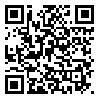Volume 28 - Supplementary
IBJ 2024, 28 - Supplementary: 13-13 |
Back to browse issues page
Download citation:
BibTeX | RIS | EndNote | Medlars | ProCite | Reference Manager | RefWorks
Send citation to:



BibTeX | RIS | EndNote | Medlars | ProCite | Reference Manager | RefWorks
Send citation to:
Khoshrou A, Khazaei S, Bakhtiari E, Khoshroo N, Hosseini S M. Comparative Analysis of Behçet's and Toxoplasmosis Treatments and Clinical Presentations: Pioneering Insights into the Etiology of Uveitis in a Northeastern Iranian Pediatric Cohort. IBJ 2024; 28 :13-13
URL: http://ibj.pasteur.ac.ir/article-1-4383-en.html
URL: http://ibj.pasteur.ac.ir/article-1-4383-en.html
Abstract:
Introduction: Early diagnosis of pediatric uveitis, a rare condition affecting 27.9 people per 100,000, is difficult due to its high morbidity and systemic disorders. Early symptoms and fear of growth retardation make this difficult. Treatment patterns for pediatric uveitis in Eastern Iran are inadequately documented, and further research is necessary to gain a comprehensive understanding of these patters. This study aimed to examine Behçet's disease and toxoplasmosis treatments and clinical presentations, providing pioneering insights into the etiology of uveitis in a Northeastern Iranian pediatric cohort
Methods and Materials: From August 2016 to August 2021, a retrospective observational study was carried out at the tertiary referral eye care center, Khatab Al Anbia Eye Hospital, located in Mashhad, northeastern Iran. All uveitis patients who were at least 18 years old at the time of presentation had their medical records reviewed. The study included patients with active uveitis who had a minimum of six months of follow-up. Patient Follow-ups were assessed through August 2021. Medical records that had partial or missing data were not included in the research. Data were extracted from the charts by skilled reviewers utilizing a standardized data collection sheet. Gender, age at presentation, presenting symptoms, etiology (infectious or autoimmune), anatomical location, ocular complications, and treatment approaches were extracted. All analyses were conducted with SPSS26.
Results: In a study of 97 pediatric uveitis cases (age: 10.5 ± 4.6 years; 52.6% female), 34 cases were related to autoimmune causes, with Behçet's disease being the most prevalent. Pain and vision impairment characterized Behçet's disease. Sixteen cases were infectious, with toxoplasmosis being the most common. Toxoplasmosis caused decreased vision and floating specks in the back of the eye. The least common type of uveitis is anterior-intermediate. Systemic steroids—prednisolone in 42.5% of cases—dominated treatment plans. Betamethasone and fluocort were given to 49.2% of patients, while triamcinolone and dexamethasone were given to 37.5%. All patients received intravitreal steroids. In 28.3% of autoimmune uveitis patients, methotrexate was the most commonly prescribed immunosuppressive medication. Most people were treated for Behçet's illness. Azathioprine, cyclosporine, infliximab, adalimumab, non-steroidal anti-inflammatory drugs, and sulfasalazine were also given. Only 4.1% of infectious uveitis cases were treated. Methotrexate, cyclosporine, and adalimumab were the most commonly prescribed medications for uveitis caused by other factors.
Conclusion and Discussion: This study illustrates the complexity of uveitis, encompassing its diverse clinical presentations and treatment options. Pediatric uveitis, in particular, highlights this complexity, with a significant incidence of autoimmune causes, notably Behçet's disease. The findings reveal a range of clinical manidestations, with toxoplasmosis emerging as a prominent infectious etiology. Treatment approaches are multimodal, placing a strong emphasis on systemic corticosteroids, such as prednisolone, alongside various immune-suppressive agents, the most commonly used being methotrexate for autoimmune patients. These data underscores the necessity for further research. The variable etiologies necessitates tailored steroid regimens, with both topical and systemic delivery methods recommended.
Methods and Materials: From August 2016 to August 2021, a retrospective observational study was carried out at the tertiary referral eye care center, Khatab Al Anbia Eye Hospital, located in Mashhad, northeastern Iran. All uveitis patients who were at least 18 years old at the time of presentation had their medical records reviewed. The study included patients with active uveitis who had a minimum of six months of follow-up. Patient Follow-ups were assessed through August 2021. Medical records that had partial or missing data were not included in the research. Data were extracted from the charts by skilled reviewers utilizing a standardized data collection sheet. Gender, age at presentation, presenting symptoms, etiology (infectious or autoimmune), anatomical location, ocular complications, and treatment approaches were extracted. All analyses were conducted with SPSS26.
Results: In a study of 97 pediatric uveitis cases (age: 10.5 ± 4.6 years; 52.6% female), 34 cases were related to autoimmune causes, with Behçet's disease being the most prevalent. Pain and vision impairment characterized Behçet's disease. Sixteen cases were infectious, with toxoplasmosis being the most common. Toxoplasmosis caused decreased vision and floating specks in the back of the eye. The least common type of uveitis is anterior-intermediate. Systemic steroids—prednisolone in 42.5% of cases—dominated treatment plans. Betamethasone and fluocort were given to 49.2% of patients, while triamcinolone and dexamethasone were given to 37.5%. All patients received intravitreal steroids. In 28.3% of autoimmune uveitis patients, methotrexate was the most commonly prescribed immunosuppressive medication. Most people were treated for Behçet's illness. Azathioprine, cyclosporine, infliximab, adalimumab, non-steroidal anti-inflammatory drugs, and sulfasalazine were also given. Only 4.1% of infectious uveitis cases were treated. Methotrexate, cyclosporine, and adalimumab were the most commonly prescribed medications for uveitis caused by other factors.
Conclusion and Discussion: This study illustrates the complexity of uveitis, encompassing its diverse clinical presentations and treatment options. Pediatric uveitis, in particular, highlights this complexity, with a significant incidence of autoimmune causes, notably Behçet's disease. The findings reveal a range of clinical manidestations, with toxoplasmosis emerging as a prominent infectious etiology. Treatment approaches are multimodal, placing a strong emphasis on systemic corticosteroids, such as prednisolone, alongside various immune-suppressive agents, the most commonly used being methotrexate for autoimmune patients. These data underscores the necessity for further research. The variable etiologies necessitates tailored steroid regimens, with both topical and systemic delivery methods recommended.

| Rights and permissions | |
 |
This work is licensed under a Creative Commons Attribution-NonCommercial 4.0 International License. |







.png)
